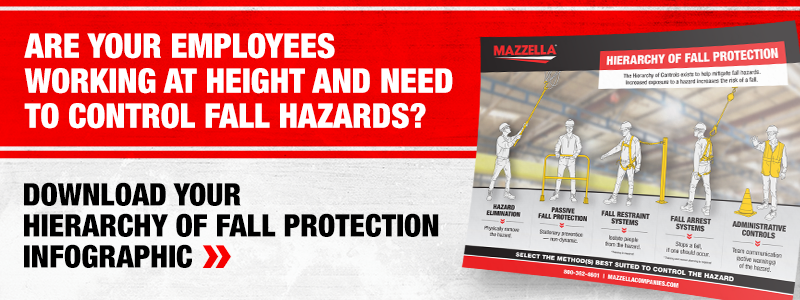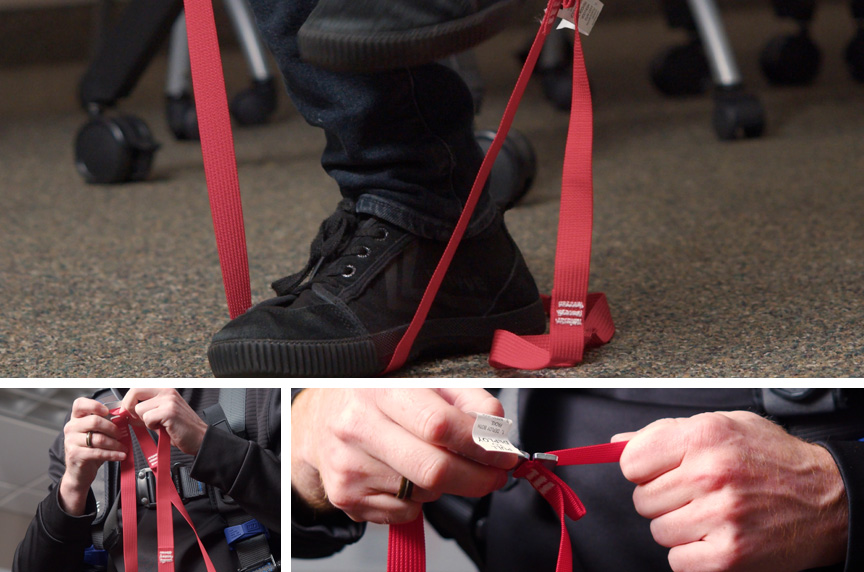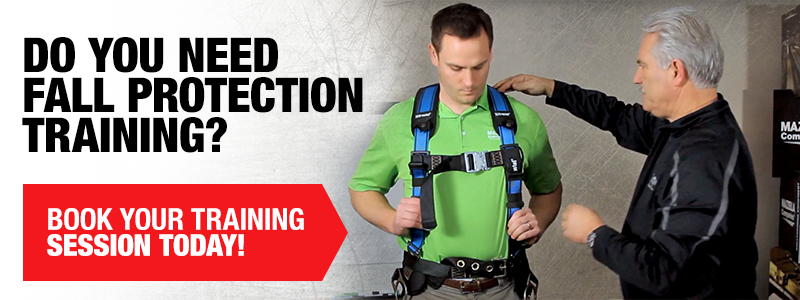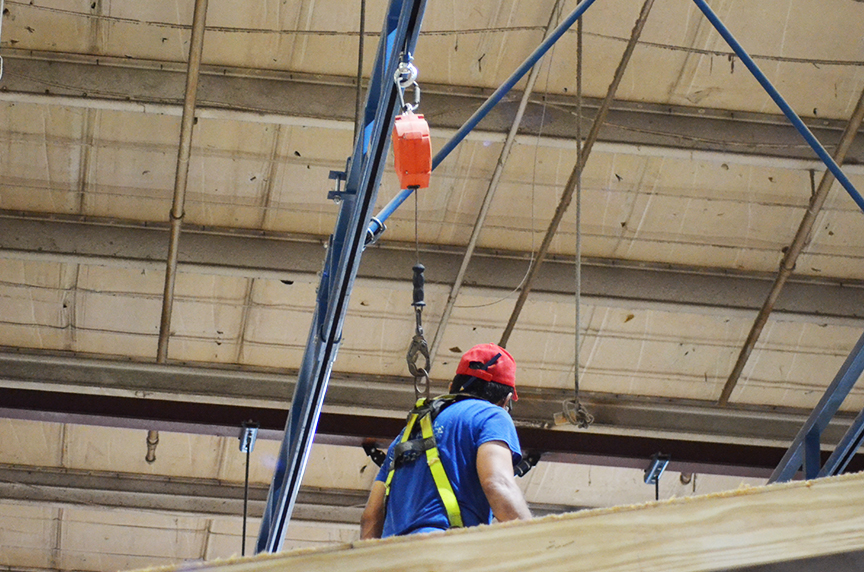How Do You Properly Fit a 3M™ DBI-SALA® ExoFit™ X300 Safety Harness?
How do you properly fit a fall protection harness? Selecting a fall protection harness is the first step in making sure you’re working safely at height. However, having a proper fitting harness is even more important. In this article, you will learn how to properly fit a 3M™ DBI-SALA® ExoFit™ X300 Safety Harness.
Falls are the leading cause of death in the construction industry, and most fatalities happen when employees fall from open-sided floors and through floor openings. Falls from as little as 4’ to 6’ can cause long-term time away from work, or death, which means all open-sided floors and platforms 6’ or more in height must be guarded.
Selecting a harness is only the first step in making sure you are protected in the event of a fall while working at height. In order for the harness to work effectively, it needs to properly fit the person wearing it.
If you just purchased your new harness, congratulations on your commitment to staying safe at height. However, if your harness is not fit properly, or if you’re not wearing it correctly, a fall can still result in a serious injury / death.
In this article, we’ll discuss how to properly fit a 3M™ DBI-SALA® ExoFit™ X300 safety harness by answering the following questions:
- Why buy a 3M™ DBI-SALA® ExoFit™ Harness?
- How do you properly fit this harness?
- Why does a new harness need an initial inspection?
- What adjustments need to be made for the harness to fit properly?
Why Buy a 3M™ DBI-SALA® ExoFit™ Harness?
First and foremost, the 3M™ DBI-SALA® ExoFit™ Harness is a very user-friendly piece of personal fall protection equipment. However, that is far from the only reason this harness has gained in popularity in recent years.
This harness has a lot of features that you can adjust so even somebody who doesn’t use it often can make it fit each time it is put into service. Also, it’s an all-purpose harness that could comfortably fit most people who work at height.
If you’re a casual roofer working on your own projects in the backyard, is this the right harness for you? The answer to that question is “Yes.”

Performing an Initial Inspection
If you just purchased the 3M™ DBI-SALA® ExoFit™ Harness, why do you need to perform an initial inspection on it?
Well, simply put, you want to make sure everything is in working order, it’s the correct product that you ordered, and meets all of your specifications and requirements. Even though new harnesses are right out of the bag or box from the manufacturer, there could be something that was damaged in shipping or in manufacturing.
You’re going to look at the following elements for damage to:
- Hardware
- D-ring or fastener deformation
- Corrosion of D-ring or fasteners
- Cracks in the D-ring or fasteners
- Loose or damaged mountings
- Webbing and Stitching
- Loose / frayed stitching
- Worn / damaged fabric
- Foreign objects adhered to the fabric
- Crushing / knots
- Cuts / holes
- Other Elements
- Non-functioning parts
- Illegal tags
If the initial inspection doesn’t show any removal from service criteria, the harness is ready to be used. Once the inspection is complete, you put on the harness and make any necessary adjustments.
How to Properly Fit Your Harness
The first thing you want to do when removing the harness from its storage area is make sure it’s not caught in knots or anything like that. To do this, you hold the harness from the D-ring and check for any entanglements or defects.
Then, if the initial inspection reveals no damage, you put on the harness with a small amount of slack. On the 3M™ DBI-SALA® ExoFit™ Harness, there are knobs to adjust the straps to either loosen or tighten the harness to your body, depending on your needs. It may take you two or three attempts to get the harness to fit how you want it.
How to Adjust Your Harness for a Proper Fit

There are many components of the 3M™ DBI-SALA® ExoFit™ Harness that will need to be adjusted to ensure a proper fit.
Side Straps
Once the harness is on, what you want to do is take the knobs on the straps (located just below your chest) and turn them clockwise. Doing so will tighten the harness straps for a more secure fit.
For this step to work, you need to be wearing the harness during the adjustments to make sure it is fitting you correctly.
Center Chest Strap
Once you buckle the center strap, you want to position it correctly.
You don’t want too much slack in the center, but you have to be careful how much you tighten the harness. You don’t want it to be so tight that it is restricting your breathing. You want to do your job comfortably without limiting your ability to breathe, talk, or move around.
To tighten the harness across your chest, pull the exposed portion of the strap until there is minimal slack.
Leg Straps
Once you tighten up the upper-body and chest straps, then you will tighten the harness’ leg straps. To make sure the fit is proper, put your hand inside the strap after your leg is in the harness. Once your wrist is covered by the strap, ball up your fist and try to pull it through. If you can, your leg straps need to be tightened.
In fitting a harness correctly, you want to ensure all components are doing their jobs. If you have it too loose, and you take a fall, you’re going to put a lot of pressure on your sternum and your back.
How Do You Adjust Suspension Trauma Straps?

Suspension trauma straps are one of the other unique features of the 3M™ DBI-SALA® ExoFit™ Harness. Each side of the harness contains a strain relief device.
If you are involved in a fall and waiting to be rescued, you can unzip pockets on both sides of the harness and release the strain relief straps. Once the strain relief straps are out of the pouch, you want to measure to just past your knees. Then, you slide in a clip to secure the left and right straps.
Once the connection is made, you can stand up straight to tighten the strain relief straps.
OSHA (the Occupational Safety and Health Administration) says you need to be rescued as quickly as possible. Otherwise, some of your extremities and internal organs will start to fail. Using the strain relief straps will help pump blood into your heart, and throughout your body, thus significantly extending the time you can wait for a rescue.
Other Unique Features on the 3M™ DBI-SALA® ExoFit™ X300 Safety Harness
On the left-hand strap of the 3M™ DBI-SALA® ExoFit™ X300 Safety Harness, there is a storage area for a radio or phone. This feature could be used in the event of a fall. If you are alone when a fall occurs, you can call for help and inform rescue workers of your location.
On the right-hand strap, there is a Velcro pouch that contains a communication device. It allows anyone with a Bluetooth device to connect and learn that the harness:
- Belongs to a certain worker
- Has been properly inspected
From a management standpoint, it’s a nice feature. If you’re going to wear a harness while working at height, managers can connect to the Bluetooth device and inform you that your harness needs to be inspected before you can go out and perform the work at height.
How Do You Store Your Harness Properly?
The 3M™ DBI-SALA® ExoFit™ X300 Safety Harness should be stored in a cool, dry place. Any exposure to UV rays can damage a harness, and eventually, cause it to be removed from service. Also, the harness should be hung from the D-ring.
It should be hooked up or placed in a locker to ensure it will be safe from environmental factors that would damage and disqualify the harness from service.
How Can Mazzella Help With Your Fall Protection Needs?

Accidents while working at height are one of the biggest causes of workplace injury and death. You need to make sure you are doing things safely and correctly. We can help with your fall protection needs, plans, equipment, and training.
Mazzella has custom-configured several types of fall protection systems for businesses across the country that have diverse needs based on their working conditions. Also, we are a distributor of The XSERIES Mobile Grabber® fall protection units and have helped several customers select and use this equipment in the field.
Mazzella is a leading supplier and installer of engineered fall protection systems in the U.S., as well as a distributor of soft goods, including harnesses, lanyards, self-retracting lifelines, scaffolding and netting. All of our engineered systems and products meet or exceed the federal criteria required by OSHA and ANSI (the American National Standards Institute) and can be customized with your individual fall protection and financial needs in mind.
We work with our partners to provide full-body harnesses, as well as many other fall protection products.
Also Mazzella specializes in site analysis and evaluation, as well as employee training for equipment installed or products sold. We offer general training, system inspection, documentation storage, and procedure development, like rescue plans.
Rigging inspections are what Mazzella is known for. However, personal fall protection inspections pair well with our rigging inspections division.
What our rigging inspectors have found over the years is that while looking at all the rigging in a facility, many of the workers using this rigging also use personal fall protection. Through our personal fall protection inspection training, we are competent to conduct these inspections.
Call us at 800.362.4601 or click here if you need harnesses or other fall protection equipment!



Fall Protection
Mazzella is a leading supplier and installer of engineered fall protection systems in the U.S., as well as a distributor of soft goods.
We specialize in site analysis and evaluation, as well as employee training for equipment installed or products sold. We also offer general training, system inspection, documentation storage, and procedure development, like rescue plans.
Copyright 2022. Mazzella Companies.
